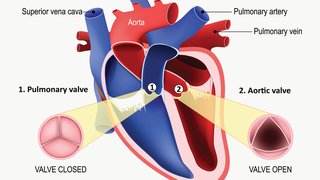You may have heard more about a heart condition known as atrial fibrillation lately thanks to an advertising campaign starring NBA Hall-of-Famer Kareem Abdul Jabbar. In fact, cardiologists are seeing more patients reporting symptoms of AFib, and many of these patients are younger.
AFib is a type of irregular heartbeat, or arrhythmia, caused by faulty electrical signals in the heart. Instead of pumping in a steady rhythm, the heart's upper and lower chambers beat out of sync, depriving the lungs of oxygen-rich blood. This might cause a fluttery feeling in the chest, shortness of breath, fatigue, and can cause blood clots.
About 6 million people in the U.S. have AFib today – and that number is expected to double by 2030. Approximately 25% of people with AFib are under 65, whereas 20-30 years ago the condition was rarely seen in midlife.
What’s causing the uptick?
More people are developing lifestyle risk factors for AFib, such as obesity, diabetes, sleep apnea, and high blood pressure. And wearable devices with built-in health monitors, such as Apple Watches, now allow people who never noticed AFib episodes before to see heart rhythm irregularities in real time.
For those with symptomatic cases of AFib, we can combine medication with cardiac ablation procedures to correct erratic heart rhythms and keep patients AFib-free for years.
Cardiac ablation is guided by a personalized propagation or “sparkle map” through real-time imaging that pinpoints the exact tissue causing abnormal electrical activity in the heart. An electrophysiologist – who specializes in diagnosing electrical issues that cause arrythmias – delivers focused energy through a thin wire inside a catheter that is guided to the problematic heart tissue from a vein in the groin. The energy destroys tissue that causes the misfiring electrical signals that cause arrhythmia and helps to restore a normal heart rhythm.
While the occasional heart flutter is normal, frequent arrhythmia that interferes with daily activities requires specialized care. Left untreated, AFib increases the risk of stroke fivefold, and it has a strong “chicken or egg” association with heart failure – AFib can cause the disease, and it doubles the risk of death in patients with existing heart failure.
Three of the most reliable ablation procedures, along with medication and a commitment to healthy lifestyle modifications, can get your heartbeat back to normal and keep you living better for longer.
3 advanced cardiac ablation techniques
Radiofrequency ablation therapy
Radiofrequency ablation (RFA) uses a low-voltage, high-frequency, alternating current of electricity to heat the tip of a catheter, zapping away problematic cardiac cells at temperatures ranging from 120-140 degrees Fahrenheit.
This minimally invasive procedure takes about 2 hours, and recovery is easy.
Data from a 4-year, multicenter clinical trial showed that a year after RFA, nearly 82% of patients with paroxysmal AFib (in which arrhythmia comes and goes on its own) no longer had AFib symptoms, and nearly 90% no longer needed heart rhythm medication. Fewer than 2% had complications, such as bleeding, healthy tissue damage, or infection.
RFA is irreversible because the heat destroys the targeted cardiac cells. We may recommend RFA for patients with recurrent AFib who cannot tolerate medication or whose symptoms are not well-controlled by it and otherwise are in good cardiovascular health.
Related reading: A Q&A with Dr. Wu: Palpitations, Arrhythmias, and Flutters

Cryoablation therapy
Cryoablation uses extremely cold thermal energy – from minus-22 to minus-75 degrees Fahrenheit – to block the flow of irregular electrical impulses. During the procedure, the electrophysiologist will use the catheter to position a 28-millimeter balloon directly against the area where the vein and heart connect. They’ll inject solution into the balloon to freeze that precise zone, then they will remove the balloon. The freezing destroys the tissue that causes AFib.
Cryoablation allows us to isolate the pulmonary vein, so we’re making very precise movements without damaging any surrounding tissue. It also has the benefit of being safe and effective.
The procedure takes about 2 hours. One-year outcomes are similar to RFA, making it a safe choice for most patients with AFib. Cryotherapy generally has a lower risk of complications than RFA. Anecdotally, if a patient goes a year without AFib symptoms, the chances are high that they’ll still be symptom-free at five years.
Related reading: A Q&A with Dr. Link: Atrial Fibrillation (AFib)
Pulsed field ablation therapy
Pulsed field ablation (PFA) delivers a “shock wave” of energy that creates holes in the cell membrane. This process, called electroporation, breaks down the structure of the cells and destroys them to prevent the irregular impulses from reaching the heart.
The effectiveness of PFA technology for management of AFib is similar to RFA and cryoablation. This procedure is nonthermal, with theoretically less risk of pulmonary vein, nerve, or esophageal tissue damage than other thermal ablative treatments, and provides greater efficiency. This procedure can take less than two hours.
PFA is relatively new for AFib treatment. The first PFA system for AFib, PulseSelect PFA, was approved by the U.S. Food and Drug Administration (FDA) in December 2023, and another, FARAPULSE, was approved in January 2024. PFA is currently offered only at advanced heart centers such as UT Southwestern.
Related reading: Catheter Ablation for AFib: Are Women Being Referred Less Than Men?

AFib risk factors
This risk assessment includes:
Congestive heart failure
Hypertension
Age (75 or older are at increased risk)
Diabetes
Stroke history
Vascular disease (such as past myocardial infarction or peripheral artery disease)
Age 65-74
Sex (women are at increased risk)
Medications for AFib
There is no existing research showing that anti-arrhythmic medications alone provide better outcomes than cardiac ablation. However, taking the right medication before and after cardiac ablation can reduce the risk of cardiovascular complications, such as stroke and heart failure.
Cardiologists use the CHA₂DS₂-VASc (pronounced Chads Vasc) scoring tool to determine whether you need blood thinners and what type.
Most AFib patients will take a blood thinner to prevent blood clots. The medication warfarin has been the standby; it prevents the production of proteins which are need to prevent bleeding, and thus the blood is thinned. Taking warfarin requires patients to test their clotting speed once a month.
A relatively new class of blood thinners, direct oral anticoagulants (DOACs), are proven to be safer and more effective than warfarin, with fewer side effects and no need for the frequent blood tests. However, they are much more expensive, which can be a barrier for some patients.
Other medicines for AFib are those that slow the heart rate during AFib, and those that prevent AFib recurrences. We typically start with safe, effective drugs called beta blockers that lower the heart rate. Other drugs that lower the heart rate are calcium channel blockers and digoxin.
Drugs that prevent recurrences of AFib are called anti-arrhythmic agents. These include flecainide, propafenone, sotalol, dofetilide, dronedarone, and amiodarone. Studies show that these medicines can be effective, but there is some risk.
Lifestyle changes
Whether your electrophysiologist recommends medication, ablation, or both, managing controllable risk factors is vital for ensuring these therapies have the best chance of success. Lifestyle modifications are as crucial in AFib prevention and treatment as they are for coronary disease.
In 2022, we launched the first-of-its-kind Atrial Fibrillation Weight Loss program to help patients address the risk factors for AFib and obesity, such as:
- High blood pressure
- Type 2 diabetes
- Sleep apnea
- Coronary artery disease
Our specialists build personalized care plans for every patient, which may include recommendations for nutrition, exercise, anti-obesity medication, and emotional support.

Wearable monitors
Wearable devices can be key in making and monitoring lifestyle changes, offering encouragement and reminders throughout the day. These devices also help monitor patients’ heart rhythms. Wearables such as the Apple Watch or Fitbit use algorithms that are about 90% accurate for heart rhythm management.
These devices can also help watch for arrhythmia in patients who are recommended to stop taking blood thinners after an ablative procedure. We are currently enrolling patients in REACT-AF, a national clinical trial to further explore this strategy. In this NIH-sponsored trial, one group of patients will take DOAC medication consistently while the other takes DOACs only if AFib lasting an hour or longer is confirmed by an AFib-sensing smartwatch and app. Providers will follow their outcomes for 3-5 years to learn whether one strategy is superior in terms of reducing the risk of stroke, embolism, or death. Talk with your health care provider if you are interested in enrolling in REACT-AF.
While ablation and medications are remarkably effective for treating AFib, neither is a cure-all. Some patients will eventually need a second or even third procedure. However, ablation in combination with medication, lifestyle changes, and ongoing monitoring can extend the time between recurrences and lower the risk of other health problems.
To schedule an appointment with an expert about AFib, call 214-645-8300 or request an appointment online.













